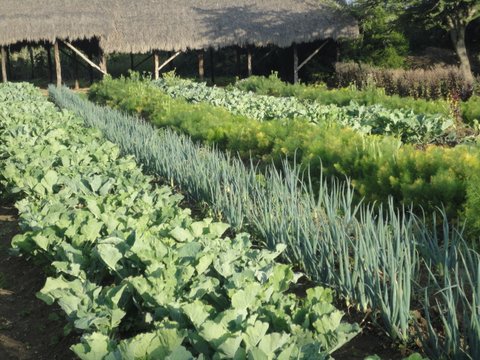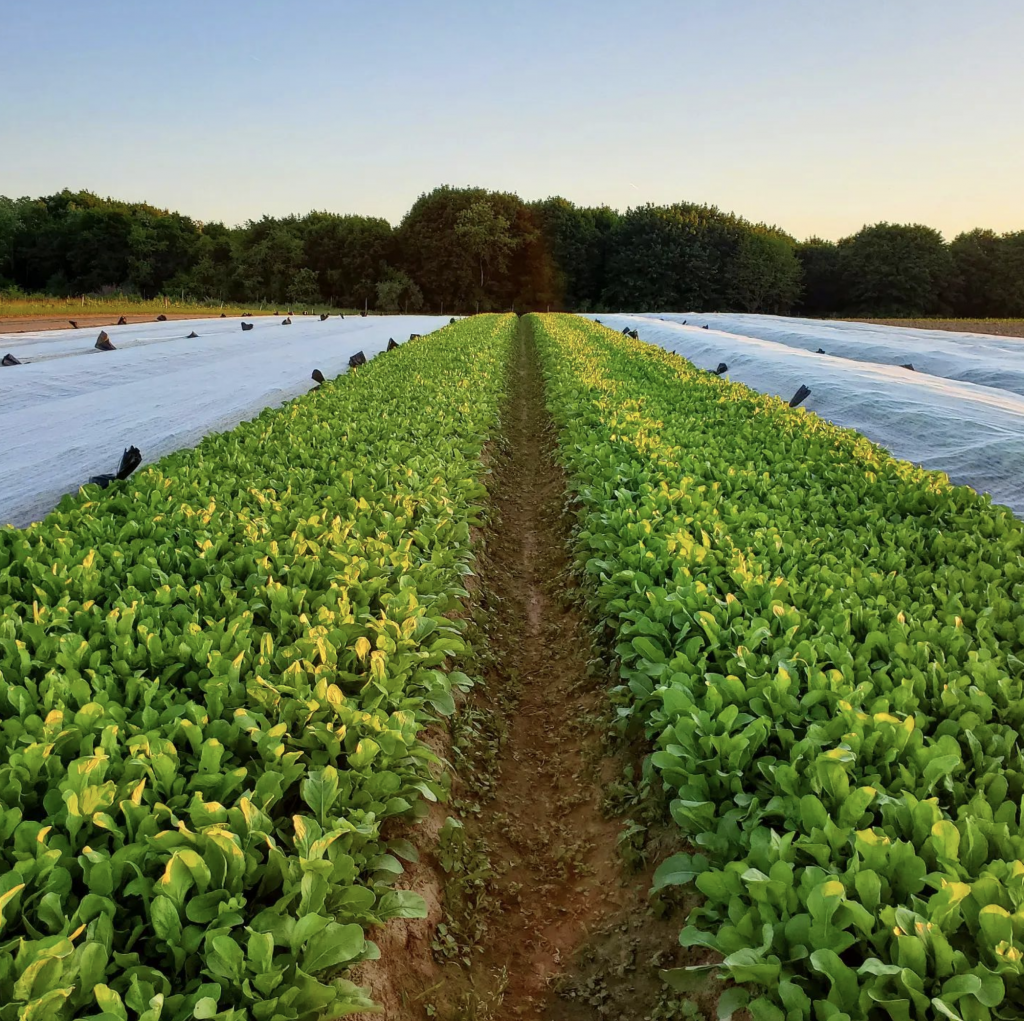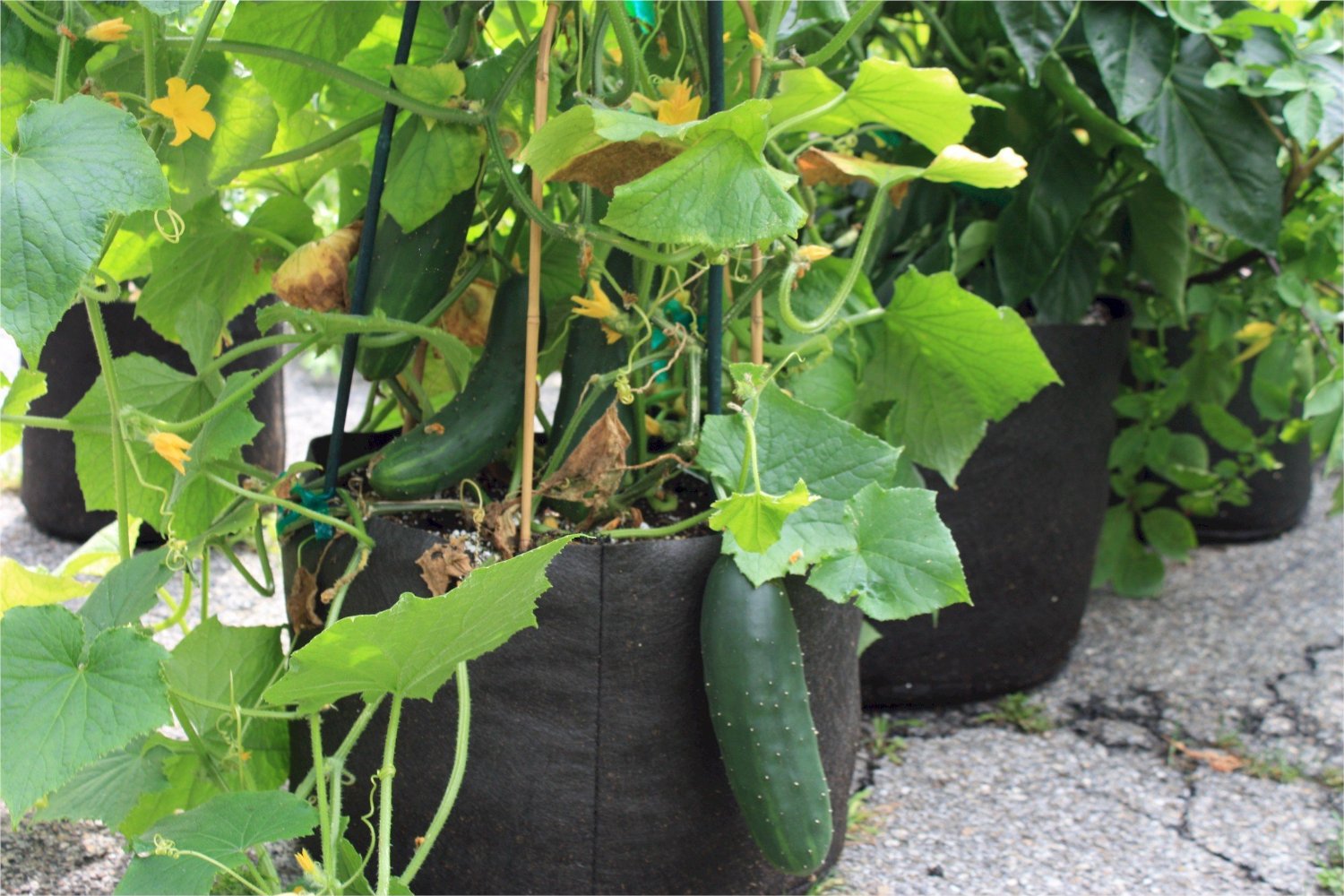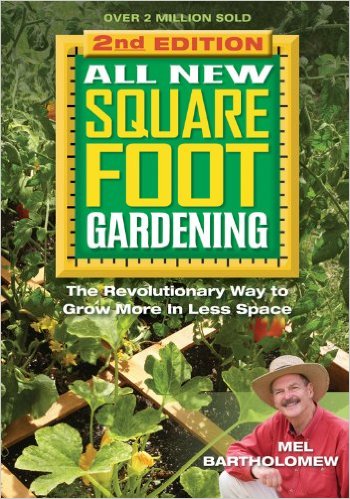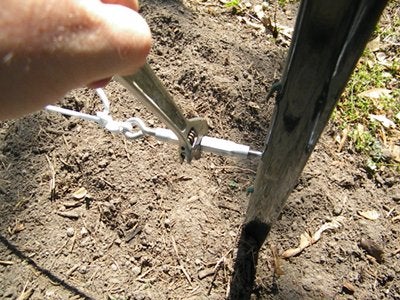Earlier in the spring I’d posted a short note about making a cat’s cradle for tomatoes. Though I am still using cages in my raised beds, I’m always looking for ideas for when my garden will expand into bigger areas. I found this detailed plan for a very sturdy looking tomato support system. The materials are simple, but look really effective. Saving for later reference!
One of the most aggravating things about growing tomatoes is finding something that will actually support them.
Unfortunately, the cages and stakes you find at garden centers and big box stores never seem to cut the mustard. They work great for the first two months, but once the plants mature it’s almost a guarantee that the tomatoes will end up on the ground.
I decided that I had to build a tomato trellis for my vegetable garden like the one Kenny used.
How to Build an Easy Tomato Trellis
What I liked about Kenny’s trellis is that it looked so easy to build and didn’t require any special tools and equipment. It also looked like you could set it up very quickly.
Simple and quick. That’s what I’m talking about!
Here’s a list of materials you will need to build the tomato trellis:
Fence T-posts
You will need to use the green T-posts normally used for fencing. How many you need will depend on how many tomatoes you are growing and how long a row you have.
I would recommend using as many T-posts as possible, because this is what will support the weight of your tomatoes. Spacing the T-posts between five to eight feet apart should give your tomatoes plenty of support.
To give you an idea of how many you may need, I have a row of tomatoes that is thirty-eight feet long. I used a total of six T-posts spaced out about seven and a half feet apart.
Purchase the tallest T-posts you can find. The tallest T-posts I could find were seven feet tall at Lowe’s. With eighteen inches in the ground that means my trellis will be about five and a half feet tall.
100 ft Roll of Plastic Clothesline
The plastic clothesline will string between the T-posts to form a “wall” for the tomato plants. The plants will be tied to the clothesline as they grow.
I opted to go with the plastic clothesline because it seemed like it would be easier to work with than the wire. You can also use 14 or 16 gauge wire as Kenny used in his tomato trellis video.
I would avoid using twine or string because I don’t think it would be strong enough once the tomatoes get real big.
Mounting Hardware
You will need some mounting hardware to attach the clothesline to the T-posts. An eye bolt and nut will be needed on one end of the trellis, while a small turnbuckle will be needed on the other end.
I like the turnbuckle because it gives you the ability to tighten the line to get it really snug for supporting the tomatoes. This may be needed later down the road if the line ever starts to sag, you can always go back and re-tightened it up again.
You will need enough eyebolts and turnbuckles to make five to six rows of clothesline. I purchased five eyebolts and turnbuckles. If I need more later I can always go back and get them.
Here’s the complete list of materials for the tomato trellis to accomodate the 38 foot tomato row:
- 6 – T-posts, seven ft tall
- 1 – 100ft roll of plastic clothesline
- 5 – 1/4″ eyebolts with nuts
- 1 – roll of string (if needed)
Setting Up the Tomato Trellis
The first thing you should do is place a T-post at each end of the row for the tomatoes. Make sure each post is plumb using a level, then use your foot to drive it into the soil until the small plate on the post is even with the soil level.
If you have compacted soil you may need to use a heavy hammer to drive the post in the ground. Lowe’s also carries a post driver tool if you need it.
With both end posts plumbed and installed, next you will need to run a string from one of the end posts to the other.
Tie the string to one side of the post and run it down to the other post and tie it to the same side of that post.
This string will be a guide so you know where to place the inner T-posts. You want the T-posts to be in a straight line.
Now space the inner T-posts equally across the distance between the two end posts. My end posts are 38 feet apart so I will space the four inner posts about seven and a half feet apart. Use the string line as a guide to keep the T-post in a straight line.
Once you have all the inner posts in the proper location drive them in the ground and check to make sure they are plumb.
Again, you want the small plate attached at the bottom of the post to be at the soil line.
Attaching the Hardware and Running the Clothesline
With all of the T-posts installed it’s time to attach the hardware and run the clothesline.
Install an eyebolt in one end post using a hole that is about ten to twelves inches above the ground. It should be the second hole from the bottom. If you want the first row of line to be lower or higher, that’s fine.
Go to the other end post and attach the turnbuckle to the same height hole as the eyebolt. Unscrew the eyebolt on one side of the turnbuckle and stick it through the hole in the T-post.
Unscrew the other eyebolt in the turnbuckle so it is out as far as it will go without coming out. Screw the turnbuckle back onto the eyebolt inserted in the post a couple of threads – just enough so it will stay on.
You want the turnbuckle extended out as far as it will go before attaching the line so you will have the full range of it for tightening.
With the eyebolt and turnbuckle installed on the end posts, tie one end of the clothesline to the turnbuckle and run the line to the other T-post.
Leave enough length of clothesline on the other end for tying a knot and cut the line with some scissors or a sharp knife.
Go to the T-post closest to the post with the turnbuckle and begin running the clothesline through the holes in the inner posts that is the same height as the turnbuckle and eyebolt you already installed.
Continue running the clothesline until you reach the T-post with the eyebolt at the other end.
Once you get to the end with the eyebolt, run the clothesline through the eye and pull the clothesline tight. You want to get the line as tight as possible, but don’t yank it so hard you pull the T-posts over.
With the clothesline tight, tie the line to the eyebolt. Make sure to tie good knots so they will hold under the tension. My grandfather used to say, “If you can’t tie a knot, tie a lot”.
Here’s where the usefulness of the turnbuckle comes in. Use a wrench on the turnbuckle to tighten the clothesline even further.
You want to get the clothesline as tight as possible, but it doesn’t need to be super tight.
Remember, you aren’t stringing a banjo here. You just want some decent tension on it.
Use one hand to hold one end of the turnbuckle while tightening with the wrench.
Just repeat the same steps for the next row of line for the trellis and continually add line as the tomato plants grow up. Once the tomato grows to a height above the clothesline simply use twine, old panty hose, or an old t-shirt cut in strips to tie the plant to the clothesline.
Continue this as the plant grows until it reaches the top of the trellis.
Hopefully no more fallen plants.
Hopefully no more flimsy cages.
I think the tomato trellis will work much better than cages or stakes. I believe this is a genius idea and I want to thank Kenny from veggiegardeningtips.com for the awesome idea!
